Abstract
BACKGROUND: Although the bronchodilating effect of inhaled anticholinergics has been established in patients with chronic obstructive pulmonary disease (COPD), their effects on exercise capacity are still controversial. Previous studies have suggested that the standard dosage hardly affects exercise tolerance, whereas higher doses might elicit an improvement. The aim of the present study was to determine the dose of ipratropium bromide aerosol that improves exercise performance using progressive cycle ergometry in patients with stable COPD. METHODS: Twenty men with stable COPD of mean (SD) age 69.2 (4.6) years and forced expiratory volume in one second (FEV1) 1.00 (0.37) 1 were studied in a randomised double blind manner. Each patient received ipratropium bromide in doses of 240 micrograms, 160 micrograms, 80 micrograms, 40 micrograms, and placebo from a metered dose inhaler (MDI) with an InspirEase spacer on five separate days. Spirometric parameters were assessed before and at 30, 60, 90, and 120 minutes after each inhalation, and pulse rate and blood pressure were also measured immediately before each spirometric measurement. Symptom limited progressive (20 watts/min) cycle ergometer exercise tests were performed 90 minutes after each inhalation. RESULTS: Ipratropium bromide in doses of 160 micrograms and 240 micrograms produced a greater increase in FEV1 than 40 micrograms or 80 micrograms ipratropium bromide at all time points. Doses of 160 micrograms and 240 micrograms ipratropium bromide also produced greater increases in maximal work load and maximal oxygen consumption than placebo, whereas 40 micrograms and 80 micrograms ipratropium bromide did not. There was a weak correlation between the change in FEV1 and the change in maximal work load (r = 0.45). No differences were found in pulse rate or blood pressure between the treatment and placebo groups, and no side effects were noted throughout the study. CONCLUSIONS: A dose of at least four times the standard dose of ipratropium bromide from an MDI with a spacer device was necessary to improve maximal cycle exercise capacity in patients with stable COPD. Although the data from cycle ergometry cannot be directly applied to exercise performed during day to day activities, it is conceivable that the recommended doses of ipratropium bromide do not elicit the optimal clinical benefits.
Full text
PDF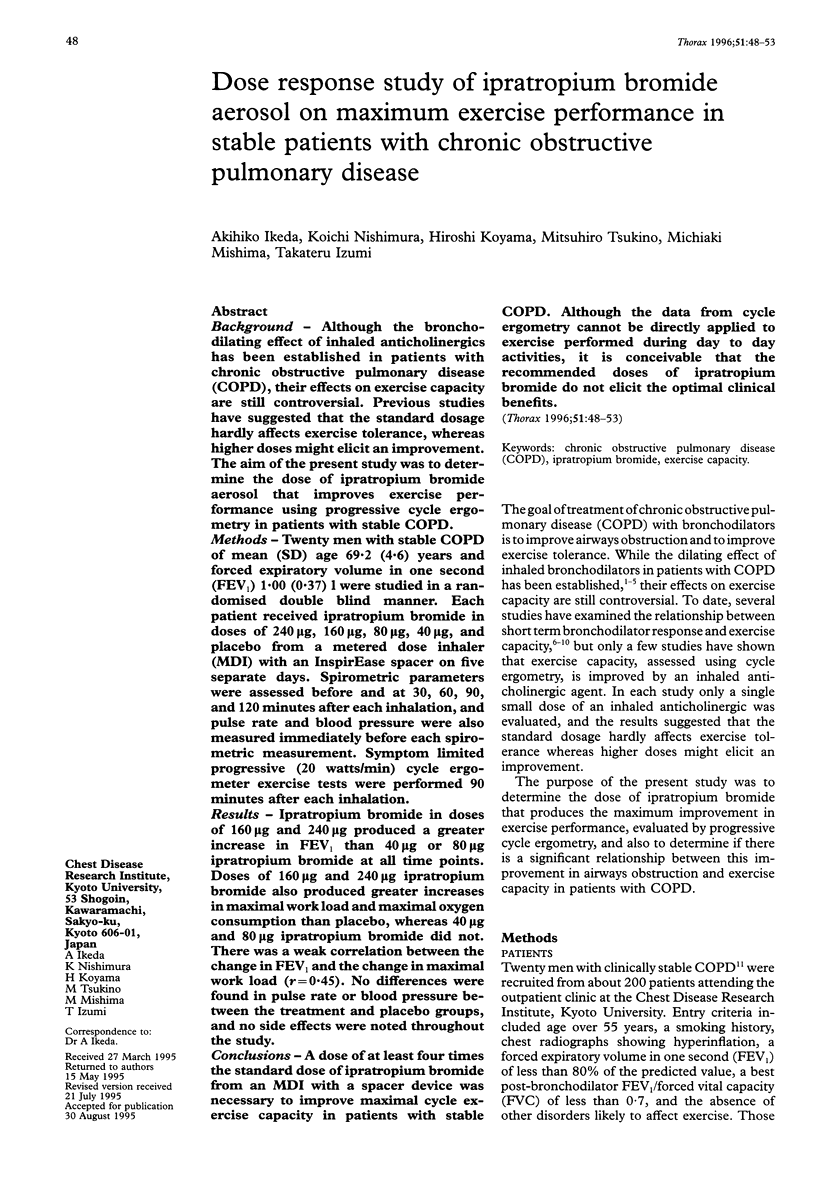
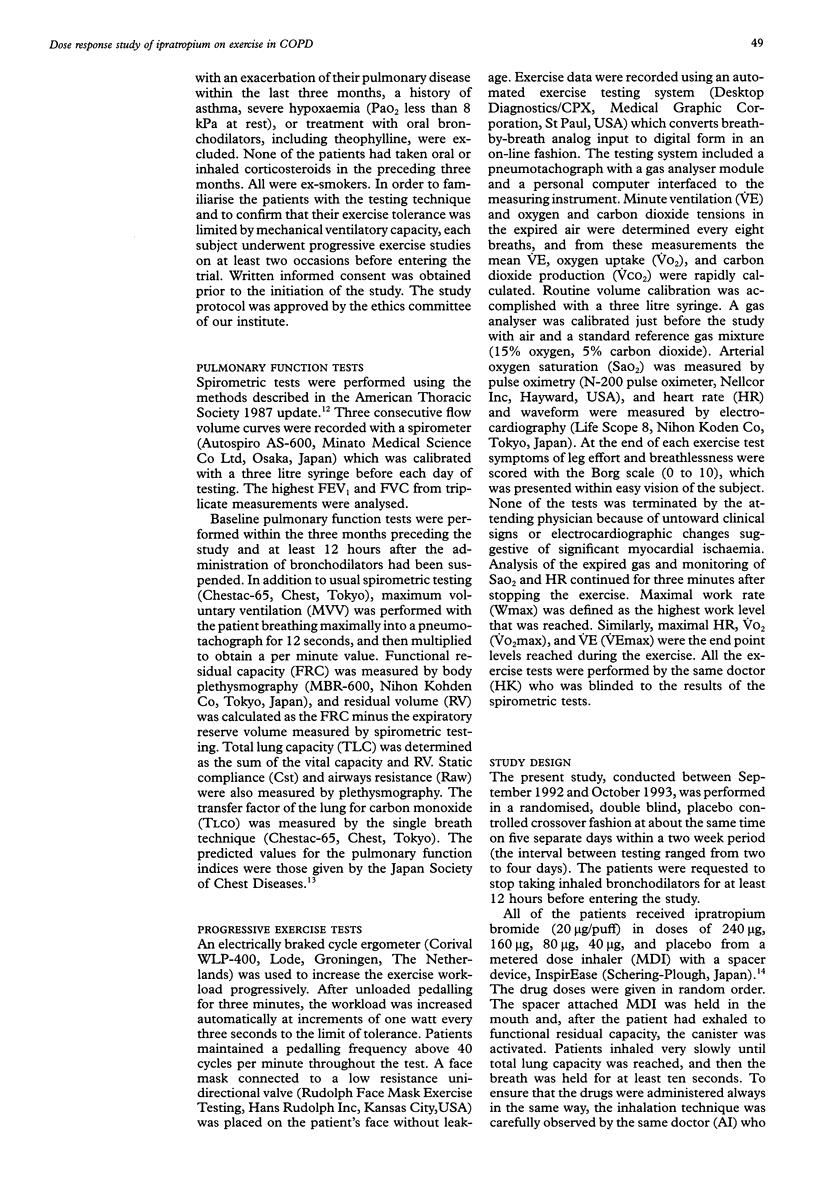
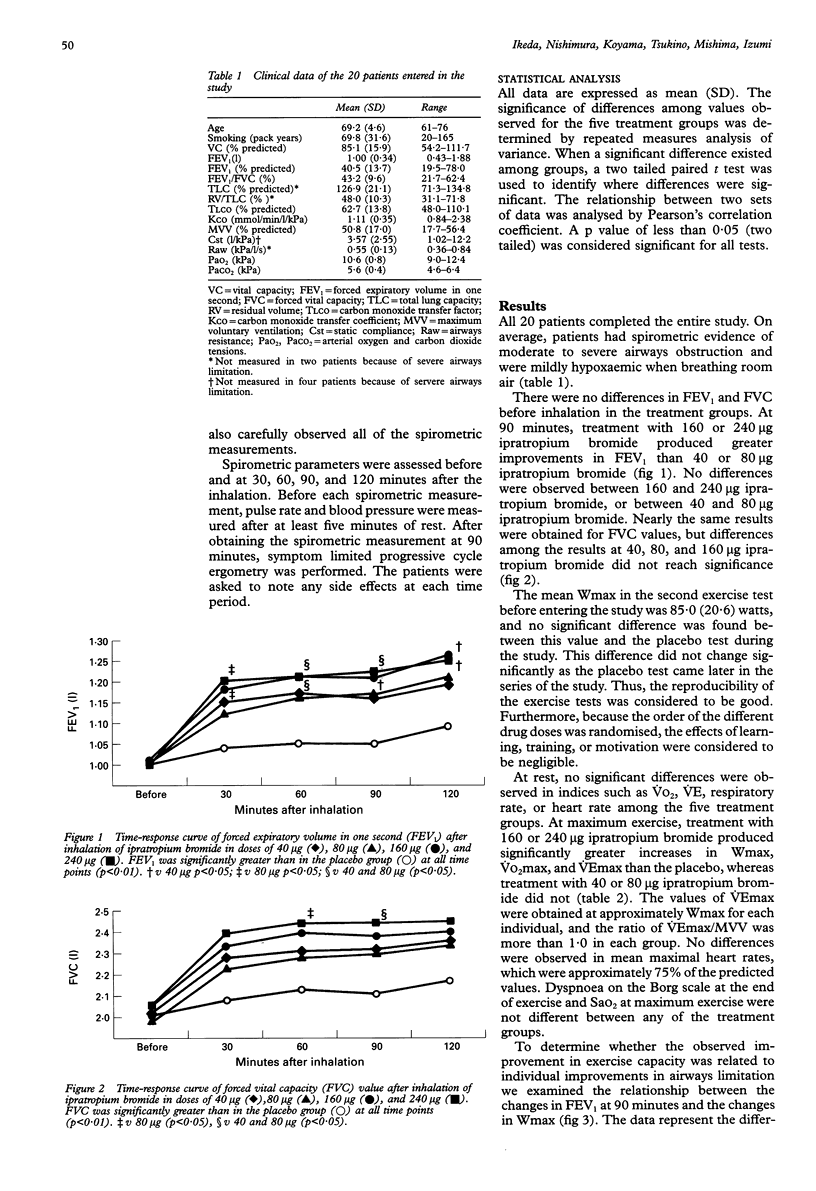
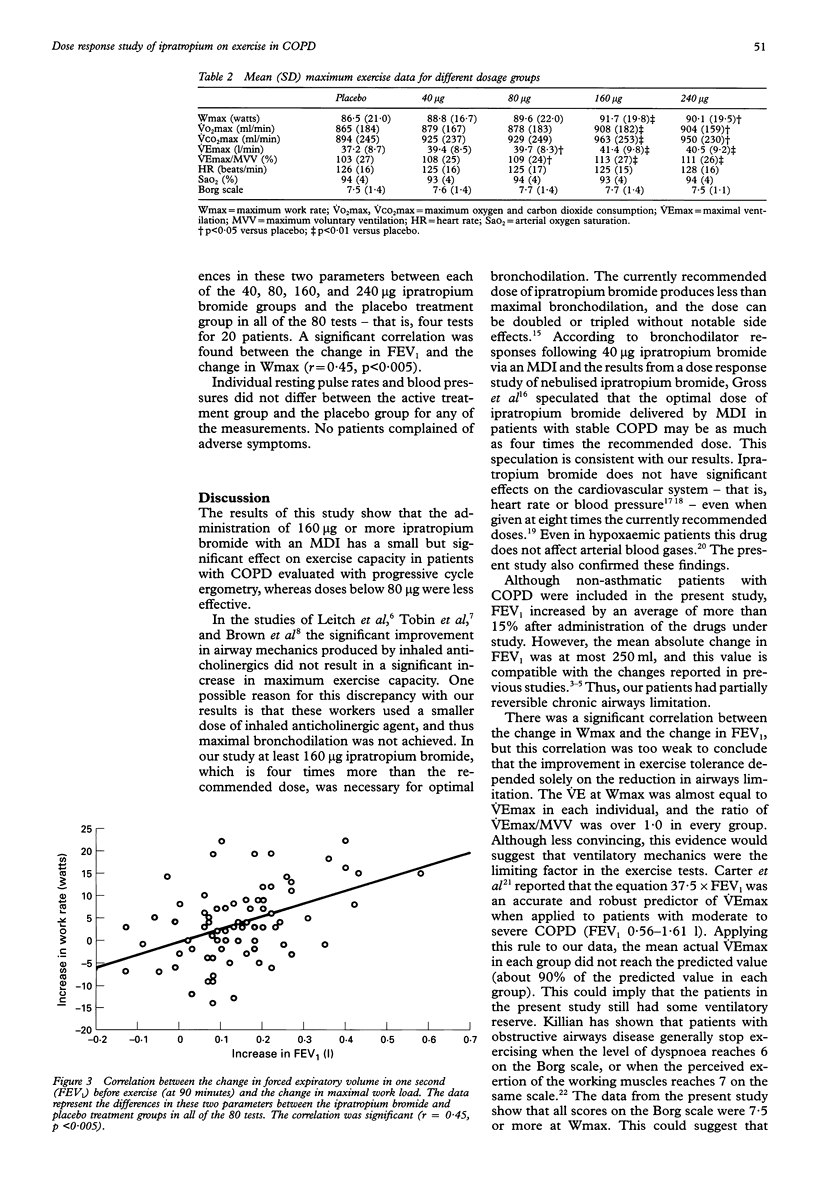
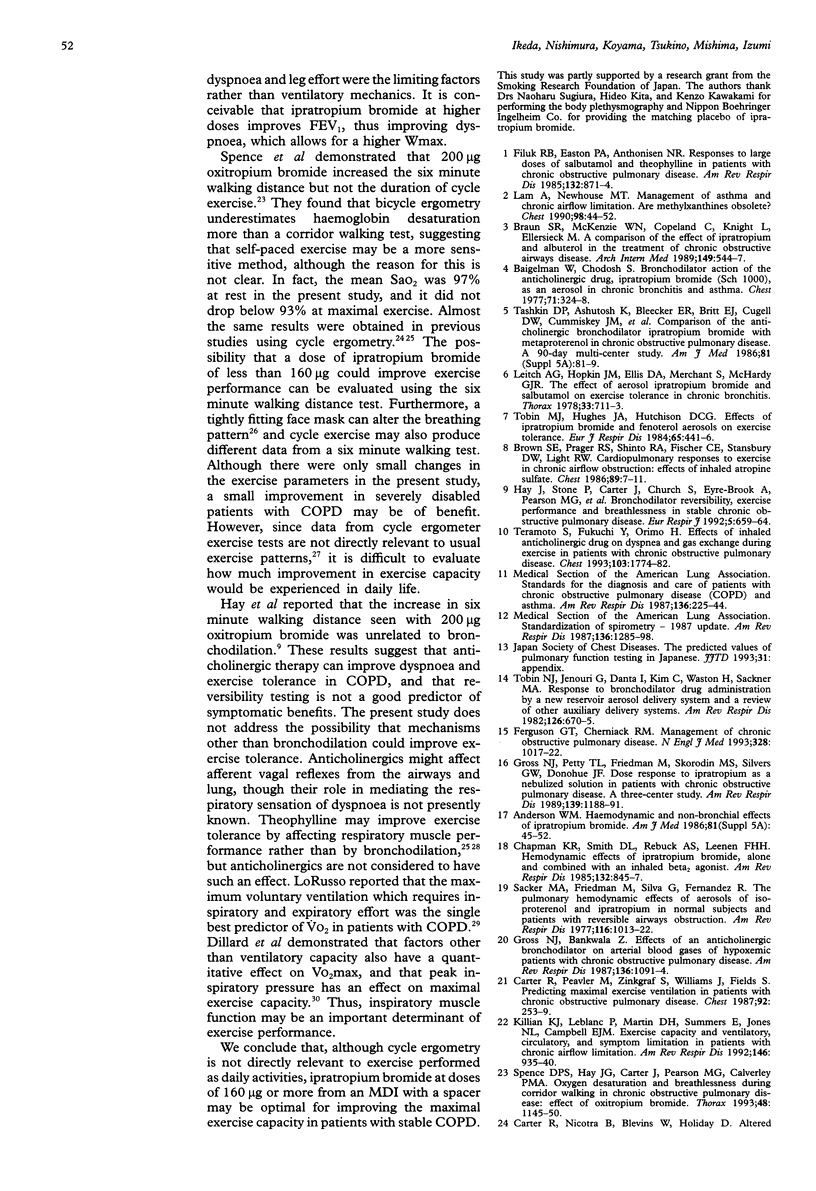
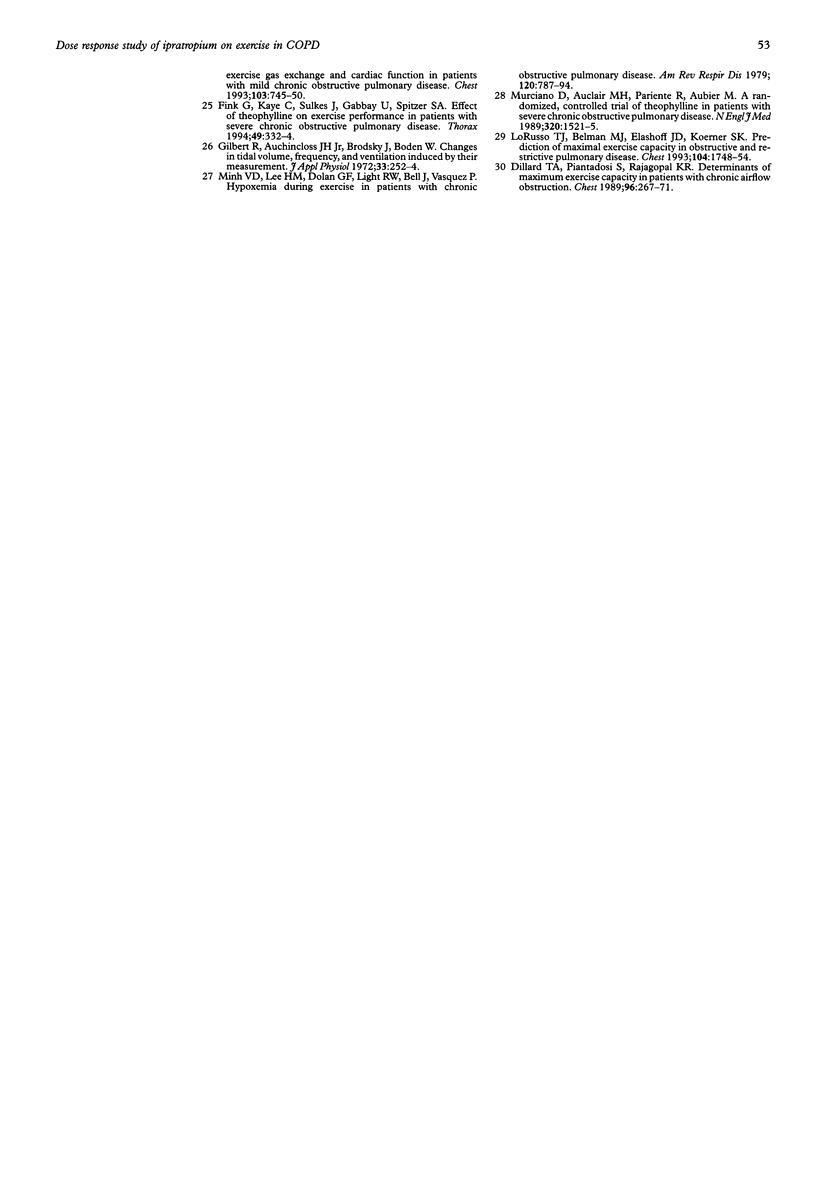
Selected References
These references are in PubMed. This may not be the complete list of references from this article.
- Anderson W. M. Hemodynamic and non-bronchial effects of ipratropium bromide. Am J Med. 1986 Nov 14;81(5A):45–53. doi: 10.1016/0002-9343(86)90461-4. [DOI] [PubMed] [Google Scholar]
- Baigelman W., Chodosh S. Bronchodilator action of the anticholinergic drug, ipratropium bromide (Sch 1000), as an aerosol in chronic bronchitis and asthma. Chest. 1977 Mar;71(3):324–328. doi: 10.1378/chest.71.3.324. [DOI] [PubMed] [Google Scholar]
- Braun S. R., McKenzie W. N., Copeland C., Knight L., Ellersieck M. A comparison of the effect of ipratropium and albuterol in the treatment of chronic obstructive airway disease. Arch Intern Med. 1989 Mar;149(3):544–547. [PubMed] [Google Scholar]
- Brown S. E., Prager R. S., Shinto R. A., Fischer C. E., Stansbury D. W., Light R. W. Cardiopulmonary responses to exercise in chronic airflow obstruction. Effects of inhaled atropine sulfate. Chest. 1986 Jan;89(1):7–11. doi: 10.1378/chest.89.1.7. [DOI] [PubMed] [Google Scholar]
- Carter R., Nicotra B., Blevins W., Holiday D. Altered exercise gas exchange and cardiac function in patients with mild chronic obstructive pulmonary disease. Chest. 1993 Mar;103(3):745–750. doi: 10.1378/chest.103.3.745. [DOI] [PubMed] [Google Scholar]
- Carter R., Peavler M., Zinkgraf S., Williams J., Fields S. Predicting maximal exercise ventilation in patients with chronic obstructive pulmonary disease. Chest. 1987 Aug;92(2):253–259. doi: 10.1378/chest.92.2.253. [DOI] [PubMed] [Google Scholar]
- Chapman K. R., Smith D. L., Rebuck A. S., Leenen F. H. Hemodynamic effects of inhaled ipratropium bromide, alone and combined with an inhaled beta 2-agonist. Am Rev Respir Dis. 1985 Oct;132(4):845–847. doi: 10.1164/arrd.1985.132.4.845. [DOI] [PubMed] [Google Scholar]
- Dillard T. A., Piantadosi S., Rajagopal K. R. Determinants of maximum exercise capacity in patients with chronic airflow obstruction. Chest. 1989 Aug;96(2):267–271. doi: 10.1378/chest.96.2.267. [DOI] [PubMed] [Google Scholar]
- Ferguson G. T., Cherniack R. M. Management of chronic obstructive pulmonary disease. N Engl J Med. 1993 Apr 8;328(14):1017–1022. doi: 10.1056/NEJM199304083281408. [DOI] [PubMed] [Google Scholar]
- Filuk R. B., Easton P. A., Anthonisen N. R. Responses to large doses of salbutamol and theophylline in patients with chronic obstructive pulmonary disease. Am Rev Respir Dis. 1985 Oct;132(4):871–874. doi: 10.1164/arrd.1985.132.4.871. [DOI] [PubMed] [Google Scholar]
- Fink G., Kaye C., Sulkes J., Gabbay U., Spitzer S. A. Effect of theophylline on exercise performance in patients with severe chronic obstructive pulmonary disease. Thorax. 1994 Apr;49(4):332–334. doi: 10.1136/thx.49.4.332. [DOI] [PMC free article] [PubMed] [Google Scholar]
- Gilbert R., Auchincloss J. H., Jr, Brodsky J., Boden W. Changes in tidal volume, frequency, and ventilation induced by their measurement. J Appl Physiol. 1972 Aug;33(2):252–254. doi: 10.1152/jappl.1972.33.2.252. [DOI] [PubMed] [Google Scholar]
- Gross N. J., Bankwala Z. Effects of an anticholinergic bronchodilator on arterial blood gases of hypoxemic patients with chronic obstructive pulmonary disease. Comparison with a beta-adrenergic agent. Am Rev Respir Dis. 1987 Nov;136(5):1091–1094. doi: 10.1164/ajrccm/136.5.1091. [DOI] [PubMed] [Google Scholar]
- Gross N. J., Petty T. L., Friedman M., Skorodin M. S., Silvers G. W., Donohue J. F. Dose response to ipratropium as a nebulized solution in patients with chronic obstructive pulmonary disease. A three-center study. Am Rev Respir Dis. 1989 May;139(5):1188–1191. doi: 10.1164/ajrccm/139.5.1188. [DOI] [PubMed] [Google Scholar]
- Hay J. G., Stone P., Carter J., Church S., Eyre-Brook A., Pearson M. G., Woodcock A. A., Calverley P. M. Bronchodilator reversibility, exercise performance and breathlessness in stable chronic obstructive pulmonary disease. Eur Respir J. 1992 Jun;5(6):659–664. [PubMed] [Google Scholar]
- Killian K. J., Leblanc P., Martin D. H., Summers E., Jones N. L., Campbell E. J. Exercise capacity and ventilatory, circulatory, and symptom limitation in patients with chronic airflow limitation. Am Rev Respir Dis. 1992 Oct;146(4):935–940. doi: 10.1164/ajrccm/146.4.935. [DOI] [PubMed] [Google Scholar]
- Lam A., Newhouse M. T. Management of asthma and chronic airflow limitation. Are methylxanthines obsolete? Chest. 1990 Jul;98(1):44–52. doi: 10.1378/chest.98.1.44. [DOI] [PubMed] [Google Scholar]
- Leitch A. G., Hopkin J. M., Ellis D. A., Merchant S., McHardy G. J. The effect of aerosol ipratropium bromide and salbutamol on exercise tolerance in chronic bronchitis. Thorax. 1978 Dec;33(6):711–713. doi: 10.1136/thx.33.6.711. [DOI] [PMC free article] [PubMed] [Google Scholar]
- LoRusso T. J., Belman M. J., Elashoff J. D., Koerner S. K. Prediction of maximal exercise capacity in obstructive and restrictive pulmonary disease. Chest. 1993 Dec;104(6):1748–1754. doi: 10.1378/chest.104.6.1748. [DOI] [PubMed] [Google Scholar]
- Minh V. D., Lee H. M., Dolan G. F., Light R. W., Bell J., Vasquez P. Hypoxemia during exercise in patients with chronic obstructive pulmonary disease. Am Rev Respir Dis. 1979 Oct;120(4):787–794. doi: 10.1164/arrd.1979.120.4.787. [DOI] [PubMed] [Google Scholar]
- Murciano D., Auclair M. H., Pariente R., Aubier M. A randomized, controlled trial of theophylline in patients with severe chronic obstructive pulmonary disease. N Engl J Med. 1989 Jun 8;320(23):1521–1525. doi: 10.1056/NEJM198906083202304. [DOI] [PubMed] [Google Scholar]
- Sackner M. A., Friedman M., Silva G., Fernandez R. The pulmonary hemodynamic effects of aerosols of isoproterenol and ipratropium in normal subjects and patients with reversible airway obstruction. Am Rev Respir Dis. 1977 Dec;116(6):1013–1022. doi: 10.1164/arrd.1977.116.6.1013. [DOI] [PubMed] [Google Scholar]
- Spence D. P., Hay J. G., Carter J., Pearson M. G., Calverley P. M. Oxygen desaturation and breathlessness during corridor walking in chronic obstructive pulmonary disease: effect of oxitropium bromide. Thorax. 1993 Nov;48(11):1145–1150. doi: 10.1136/thx.48.11.1145. [DOI] [PMC free article] [PubMed] [Google Scholar]
- Tashkin D. P., Ashutosh K., Bleecker E. R., Britt E. J., Cugell D. W., Cummiskey J. M., DeLorenzo L., Gilman M. J., Gross G. N., Gross N. J. Comparison of the anticholinergic bronchodilator ipratropium bromide with metaproterenol in chronic obstructive pulmonary disease. A 90-day multi-center study. Am J Med. 1986 Nov 14;81(5A):81–90. doi: 10.1016/0002-9343(86)90468-7. [DOI] [PubMed] [Google Scholar]
- Teramoto S., Fukuchi Y., Orimo H. Effects of inhaled anticholinergic drug on dyspnea and gas exchange during exercise in patients with chronic obstructive pulmonary disease. Chest. 1993 Jun;103(6):1774–1782. doi: 10.1378/chest.103.6.1774. [DOI] [PubMed] [Google Scholar]
- Tobin M. J., Hughes J. A., Hutchison D. C. Effects of ipratropium bromide and fenoterol aerosols on exercise tolerance. Eur J Respir Dis. 1984 Aug;65(6):441–446. [PubMed] [Google Scholar]
- Tobin M. J., Jenouri G., Danta I., Kim C., Watson H., Sackner M. A. Response to bronchodilator drug administration by a new reservoir aerosol delivery system and a review of other auxiliary delivery systems. Am Rev Respir Dis. 1982 Oct;126(4):670–675. doi: 10.1164/arrd.1982.126.4.670. [DOI] [PubMed] [Google Scholar]


